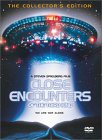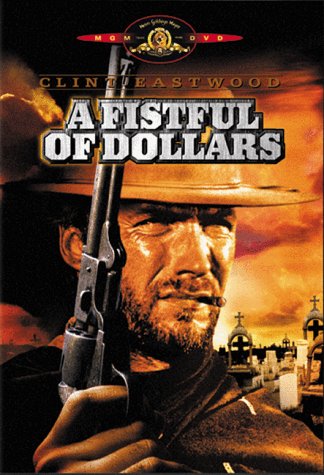 :
Study Questions: Week One
:
Study Questions: Week One :
Study Questions: Week One
:
Study Questions: Week One
Foundational Myths: Happy Childhoods and Transcendent Heroes.
Fistful of Dollars (1964/67)
Close Encounters of the Third Kind (1977)
In these two films we want to look for some of the visual motifs, characters, settings, and themes which will reappear often in films by Clint Eastwood and Stephen Spielberg. Among these are the appearance of the Eastwood hero in a Fistful of Dollars, the director's view of modern society and culture, and his transformation of the classic western hero. Close Encounters develops his particular themes and subjects: a childlike view of the adult world, life in modern suburbia, a yearning for innocence, and a taste for narratives with strong appeal for children and adolescents. It also offers a fine introduction to Spielberg's talents as film maker.
 1.
What is the significance
of Close Encounter's prologue dealing with the WWII planes discovered
in the Mexican desert? How
does it point to a recurring subject in Spielberg's later films (i.e. Empire
of the Sun, Schindler's List, and Saving Private Ryan)?
1.
What is the significance
of Close Encounter's prologue dealing with the WWII planes discovered
in the Mexican desert? How
does it point to a recurring subject in Spielberg's later films (i.e. Empire
of the Sun, Schindler's List, and Saving Private Ryan)?
2. Why, in your estimation, does a child first see evidence of the space aliens? How, exactly is this evidence manifested, and how does it reflect a child's experience. Why is he so eager to go to the aliens while the figures of authority want to capture them?
3. How would you describe the relations among members of Roy Neary's family? How does his family differ from the idealized TV family, and how does the film suggest a comparison with them?
4. How does the research into UFOs undertaken by Claude Lacombe reflect the universal influence of the aliens, and how can we see that the influence is benevolent rather than malign (as in films such as Terminator and Independence Day).
5. What do the visuals and the sounds associated with the UFO contribute to our judgment of the aliens? To what degree do the visuals (here and elsewhere) contribute to the pleasure of watching the film even if they are not directly related to the plot?
6. How are the agents of the government and the military treated by Spielberg? How do they suggest a division between the American people and their governing institutions, between authority and community?
7. Why might Roy's sculpting the Devil's Tower in Wyoming be seen both as a desire to escape his suburban life and a yearning for spiritual transcendence?
8. When the UFO finally arrives at the Devil's Tower, scientists and military officers mistake three small ships for the UFO itself. How does this scene make the arrival of the mother ship more impressive? (For those who have seen Independence Day, how does the opening sequence echo Spielberg's space ship?)
9. How does the return of the pilots and the boy assure audiences that the aliens mean well?
10. Roy leaves with the aliens in the revised version of the film. Is there an unresolved conflict between his desire for self-fulfillment and his human responsibilities (i.e. to his family)? Is there something basically childlike in Roy? It it a good quality?
11. How is the character of No Name in Fistful of Dollars established visually even before he speaks to any of the townspeople? More broadly how does the film tell its story visually? Pick out a few examples.
12. Why is the relationship between the characters, the origins of the conflict between the Rojos and the Baxters, the identity of Marisol and others so mysterious and confusing? How might the confusion contribute to the film's moral ambiguities (i.e. the refusal to define clearly the innocents and the villains)?
13. How might the strange town be seen as a metaphor for a fallen world consumed by violence and greed ("get rich" or "get killed" says one of the townspeople)?
14. How does No Name's first encounter with gunmen exaggerate and almost parody a familiar scene in westerns? Would you consider the entire film a comic exaggeration of the Hollywood western. Why exactly? Why not?
15, What motivates No Name? How does his motivation differ from the classic western hero?
16. Why does No Name spend so much time watching rather than acting? How does watching define his relation to society in general?
17. Would you describe the violence as unnecessarily brutal? Does it contribute anything to the film's narrative and themes? Consider No Name's beating and the massacre of the Baxters.
18. Why is No Name carried off in a coffin? What might the sequence symbolize thematically?
19. How does No Name's physical recovery and preparation for the final shoot-out become a metaphor for his rising from the dead?
20. Why do we see No Name from Radii's perspective during the shoot-out? How does his body armor make him appear supernatural, godlike?